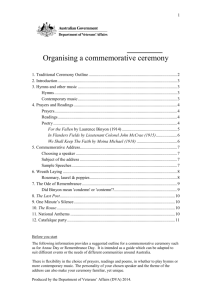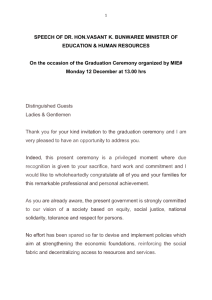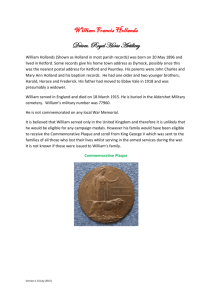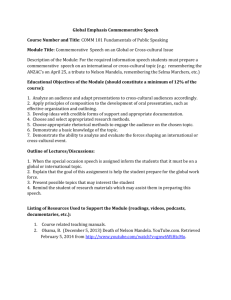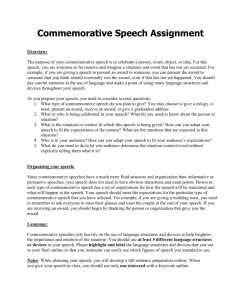Organising a commemorative ceremony - Anzac Portal
advertisement
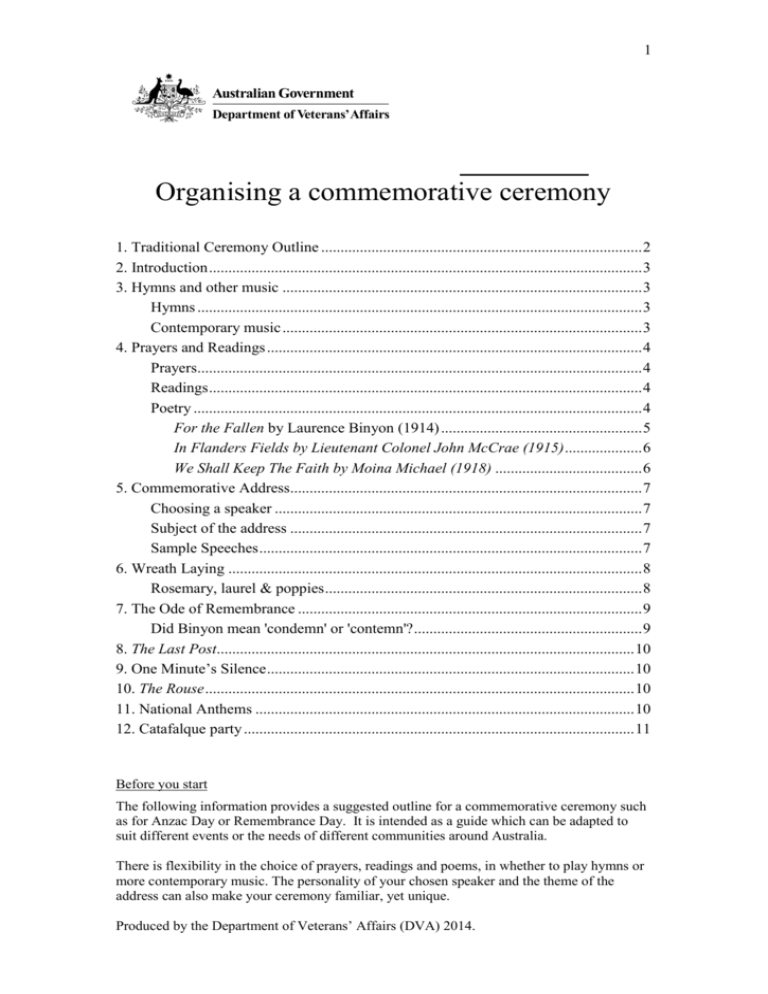
1 Organising a commemorative ceremony 1. Traditional Ceremony Outline ................................................................................... 2 2. Introduction ................................................................................................................ 3 3. Hymns and other music ............................................................................................. 3 Hymns ................................................................................................................... 3 Contemporary music ............................................................................................. 3 4. Prayers and Readings ................................................................................................. 4 Prayers................................................................................................................... 4 Readings ................................................................................................................ 4 Poetry .................................................................................................................... 4 For the Fallen by Laurence Binyon (1914) .................................................... 5 In Flanders Fields by Lieutenant Colonel John McCrae (1915) .................... 6 We Shall Keep The Faith by Moina Michael (1918) ...................................... 6 5. Commemorative Address........................................................................................... 7 Choosing a speaker ............................................................................................... 7 Subject of the address ........................................................................................... 7 Sample Speeches ................................................................................................... 7 6. Wreath Laying ........................................................................................................... 8 Rosemary, laurel & poppies .................................................................................. 8 7. The Ode of Remembrance ......................................................................................... 9 Did Binyon mean 'condemn' or 'contemn'? ........................................................... 9 8. The Last Post............................................................................................................ 10 9. One Minute’s Silence ............................................................................................... 10 10. The Rouse ............................................................................................................... 10 11. National Anthems .................................................................................................. 10 12. Catafalque party ..................................................................................................... 11 Before you start The following information provides a suggested outline for a commemorative ceremony such as for Anzac Day or Remembrance Day. It is intended as a guide which can be adapted to suit different events or the needs of different communities around Australia. There is flexibility in the choice of prayers, readings and poems, in whether to play hymns or more contemporary music. The personality of your chosen speaker and the theme of the address can also make your ceremony familiar, yet unique. Produced by the Department of Veterans’ Affairs (DVA) 2014. 2 1. Traditional Ceremony Outline Flags lowered to half mast 2 mins* Introduction/Welcome 1 min Mounting of catafalque party (if applicable) 2-4 mins Hymns or other music** 2-5 mins Prayers and Readings 3-5 mins Commemorative Address 3-5 mins Wreath Laying 1 min The Ode 1 min 22 sec The Last Post 1 min One minute’s silence (11 am precisely for Remembrance Day) 22 sec The Rouse During the playing of the Rouse, flags are to be raised slowly to the masthead 1-3 mins National anthem/s Dismounting of catafalque party 1 min (if applicable) 2 mins Closing Remarks * timing is only an approximation ** Music to support commemorative ceremonies is available free of charge from DVA. Email commemorations@dva.gov.au to request a copy. 3 2. Introduction A brief introduction should welcome all those attending the ceremony. It could make reference to the significance of the day and the Anzac tradition, or provide a thought provoking question about the meaning of the ceremony or event. For ceremonies at a school, the introduction could be given by the Principal or a student explaining why you are holding the ceremony and why it is important. The introduction could explain the reasons for the different aspects of the ceremony (the laying of wreaths or poppies, the Ode, the bugle calls and of course, the period of silence). Students could be encouraged to think about the significance and meaning of the ceremony ahead. 3. Hymns and other music Music can have a profound effect on the atmosphere of any commemorative ceremony. For Anzac Day and Remembrance Day ceremonies the music selected is usually serious yet inspiring. Hymns Three hymns that may be chosen for commemorative ceremonies include: O Valiant Hearts; Abide With Me; and O God, Our Help in Ages Past. These hymns are included in DVA’s free Music for a Commemorative Ceremony – with hymns that can be requested from commemorations@dva.gov.au. These tracks can also be downloaded for free as MP3 files from www.anzacportal.dva.gov.au. Contemporary music Contemporary music can be equally effective and there is a wealth of songs or personal compositions that can be sung or performed to enrich your ceremony. The choice of music for your commemorative ceremony is endless and ultimately depends upon the tone you hope to create and what you decide will have the most impact upon your audience. 4 4. Prayers and Readings Prayers, readings and poetry often form a part of commemorative ceremonies. While prayers are often included in traditional ceremonies, readings and poetry can substitute or complement this religious aspect of the ceremony. Prayers Prayers which are often included in ceremonies include: The Lord’s Prayer Psalm 23: 1-6 – The Lord Is My Shepherd John 15: 10-13 Micah 4: 3-5 Ephesians 6: 13-15 The Prayer of Remembrance is also a popular inclusion in ceremonies: Today we remember with thanksgiving those who made the supreme sacrifice for us in time of war. We pray that the offering of their lives may not have been in vain. Today we dedicate ourselves to the cause of justice, freedom and peace; and for the wisdom and strength to build a better world. Readings Readings of epitaphs, wartime letters written by soldiers or those on the home front can also have a powerful effect in the setting of a commemorative ceremony. Students may find it enriching to spend time discovering and researching these letters in the lead-up to the commemorative ceremony. Poetry Several famous and moving First World War poems have been commonly used in commemorative ceremonies. These include For the Fallen by Laurence Binyon (1914); In Flanders Fields by Lieutenant Colonel John McCrae MD (1915); and We Shall Keep the Faith (written in reply to Lt Col McCrae) by Moina Michael (1918). These poems have been reproduced below for convenience. 5 For the Fallen by Laurence Binyon (1914) With proud thanksgiving, a mother for her children, England mourns for her dead across the sea. Flesh of her flesh they were, spirit of her spirit, Fallen in the cause of the free. Solemn the drums thrill: Death August and royal Sings sorrow up into immortal spheres. There is music in the midst of desolation And a glory that shines upon our tears. They went with songs to the battle, they were young, Straight of limb, true of eye, steady and aglow. They were staunch to the end against odds uncounted; They fell with their faces to the foe. They shall grow not old, as we that are left grow old: Age shall not weary them, nor the years condemn. At the going down of the sun and in the morning We will remember them. They mingle not with their laughing comrades again; They sit no more at familiar tables of home; They have no lot in our labour of the day-time; They sleep beyond England's foam. But where our desires are and our hopes profound, Felt as well-spring that is hidden from sight, To the innermost heart of their own land they are known As the stars are known to the Night; As the stars that shall be bright when we are dust, Moving in marches upon the heavenly plain; As the stars that are starry in the time of our darkness, To the end, to the end, they remain. See further: The Ode of Remembrance 6 In Flanders Fields by Lieutenant Colonel John McCrae (1915) In Flanders fields the poppies blow Between the crosses, row on row That mark our place; and in the sky The larks, still bravely singing, fly Scarce heard amid the guns below. We are the dead. Short days ago We lived, felt dawn, saw sunset glow, Loved and were loved, and now we lie In Flanders fields. Take up our quarrel with the foe; To you, from failing hands, we throw The torch; be yours to hold it high. If ye break faith with us who die We shall not sleep, though poppies grow In Flanders fields. We Shall Keep The Faith by Moina Michael (1918) Oh! you who sleep in Flanders Fields, Sleep sweet - to rise anew! We caught the torch you threw And holding high, we keep the Faith With All who died. We cherish, too, the poppy red That grows on fields where valour led; It seems to signal to the skies That blood of heroes never dies, But lends a lustre to the red Of the flower that blooms above the dead In Flanders Fields. And now the Torch and Poppy Red We wear in honour of our dead. Fear not that ye have died for naught; We'll teach the lesson that ye wrought In Flanders Fields. If you are organising a school ceremony, an option that may engage students is to have them research or write their own poem. 7 5. Commemorative Address Choosing a speaker The commemorative address can be given by an ex-serviceman or woman, serving member of the Australian Defence Force (ADF), a local dignitary, or a teacher or student in schools. Try contacting a local ex-service organisation, like the RSL, to secure a veteran for your ceremony. Enquiries about the participation of current serving members of the ADF should be directed to the Department of Defence. Subject of the address The commemorative address will naturally change depending on the event being commemorated. It is fitting on Anzac Day and Remembrance Day for the speaker to remind us of those we commemorate and to highlight the service and sacrifice of men and women in all conflicts. Providing examples of the impact of war on the local community is also a common theme. Sample Speeches For those preparing an address, some inspiration may be found by reading these memorable speeches: Anzac Day addresses for the general public (Australian Army website) o http://www.army.gov.au/Our-history/Traditions/ANZACDay/Suggested-materials-for-ANZAC-Day Remembrance Day 1993 – Paul Keating (Australian War Memorial website) o http://www.awm.gov.au/commemoration/keating.asp Remembrance Day 1997 – John Howard (Australian War Memorial website) o http://www.awm.gov.au/events/talks/anzac-1997/ 8 6. Wreath Laying Flowers have traditionally been laid on graves or memorials to commemorate the dead. Laying a wreath of flowers is a way to show respect and an integral part of many commemorative ceremonies. The suggested procedure for laying a wreath is to: approach the memorial with the wreath in your right hand; halt, pause and then lay the wreath; straighten up, step back a pace, pause; for service personnel, salute and then pause once more; move away. For a school ceremony, students could make a wreath from fresh or dried flowers. They could lay wreaths or fresh or artificial poppies at a memorial, honour board, flagpole or a designated place within the school grounds. Rosemary, laurel & poppies Rosemary and laurel especially have been associated with Anzac Day. In Ancient Rome, laurel was worn by emperors, while victorious generals and early Olympians were crowned with a laurel wreath. So it has come to symbolise bravery and victory. As a round wreath, laurel represents eternity, making it even more apt as a commemorative wreath. Rosemary is an ancient symbol of remembrance. It has added significance for Australians on Anzac Day as it grows wild on the Gallipoli Peninsula. Sprigs of rosemary are traditionally worn on Anzac Day and sometimes Remembrance Day. Poppies have long been integral to Remembrance Day and in recent years have become increasingly popular in Anzac Day wreaths. See further: Commemoration – Red Poppies (Australian War Memorial website) http://www.awm.gov.au/commemoration/customs/poppies/ 9 7. The Ode of Remembrance The Ode for commemorative ceremonies is the famous fourth stanza from For the Fallen, a poem by the English poet and writer Laurence Binyon, which was first published in London's The Times newspaper on 21 September 1914. This compelling verse, which became the Ode of Remembrance in common usage across the Commonwealth, has been used in association with commemoration services since 1921: They shall grow not old, as we that are left grow old; Age shall not weary them, nor the years condemn. At the going down of the sun and in the morning We will remember them. (Audience responds) We will remember them. Did Binyon mean 'condemn' or 'contemn'? Binyon wrote For the Fallen in the early days of the First World War. By mid September 1914, less than seven weeks after the outbreak of war, the British Expeditionary Force in France had already suffered severe casualties. Long lists of the dead and wounded appeared in British newspapers. It was against this background that the poem was written. When first published in The Times on 21 September 1914, the word 'condemn' was used. Some people suggested that the use of 'condemn' (meaning to strongly disapprove of, or to impose penalty on) in The Times was a typographical error and that 'contemn' (meaning to treat someone with contempt) was intended. However, in The Winnowing Fan, published a month or two later and for which Binyon would have had galley proofs on which to mark amendments, 'condemn' was again used. Binyon was a highly educated man and very precise in his use of words. There is no doubt that had he intended 'contemn', then it would have been used. Dr John Hatcher, who in 1955 published a biography of Binyon, does not refer to any doubt over condemn/contemn, despite devoting a solid chapter to For the Fallen. The British Society of Authors, executors of the Binyon estate, says the word is definitely "condemn", while the British Museum, where Binyon worked, says its memorial stone also shows "condemn". Both expressed surprise when told there had been some debate about the matter in Australia. The condemn/contemn issue seems to be a distinctly Australian phenomenon. Inquiries with the British, Canadian and American Legions revealed that none had heard of the debate. 'Contemn' is not used in Binyon’s published anthologies and the two volume set, Collected Poems, regarded as the definitive version of Binyon’s poems, also uses 'condemn'. The RSL handbook shows 'condemn' and a representative of the Australian War Memorial said it always used 'condemn' in its ceremonies. There would seem to be no grounds to argue otherwise: 'age shall not weary them, nor the years condemn'. 10 8. The Last Post In the military, The Last Post traditionally marks the end of the working day. The Last Post is also played during commemorative ceremonies as a poignant tribute to the dead. To learn more about the history of The Last Post, see the Australian War Memorial’s website at http://www.awm.gov.au/commemoration/customs/last-post. 9. One Minute’s Silence A minute’s silence is included as a sign of respect. It offer time for reflection on the significance of the ceremony and those being remembered. 10. The Rouse The Rouse is played following the minute’s silence and was a traditional bugle call to call soldiers to duty. As The Rouse is played, flags should be slowly raised to the masthead. At the end of The Rouse, the MC or reader of The Ode says ‘Lest we forget.’ The people gathered repeat ‘Lest we forget.’ At Dawn services, the Reveille is played. To learn more about the history of The Rouse and Reveille, see the Australian Army’s website at http://army.gov.au/Our-history/Traditions/The-Rouse-and-the-Reveille. 11. National Anthems A commemorative ceremony is generally concluded by the singing of the Australian National Anthem. If the public desire other anthems to be played, for example the New Zealand anthem on Anzac Day, then the Australian National Anthem should be played last. The first verses of both Advance Australia Fair and God Defend New Zealand are provided on DVA’s new Music for a Commemorative Ceremony CD. A two-verse version of Advance Australia Fair will be available on DVA’s Anzac Portal at www.anzacportal.dva.gov.au. 11 12. Catafalque party A catafalque is a raised bier or platform, often moveable, that is used to support a coffin during a funeral or memorial service. For ceremonial purposes, such as Anzac Day or Remembrance Day ceremonies, it can be represented by a shrine or remembrance stone, a 'symbolic coffin'. A catafalque party is a guard of four service personnel mounted over a catafalque during a funeral, a period of lying in state or a memorial service or occasion such as Anzac Day or Remembrance Day. The catafalque party is posted at the four corners of the catafalque, heads lowered, facing outwards with their rifles reversed as a mark of respect and to signify that the dead are now at peace. In a school ceremony, four students could be posted as the catafalque party to stand quietly to attention throughout the service. An explanation of the significance of the catafalque party would be appropriate and could be given during the ceremony or on a program. For more information, see http://army.gov.au/Our-history/Traditions/CatafalqueParty.
